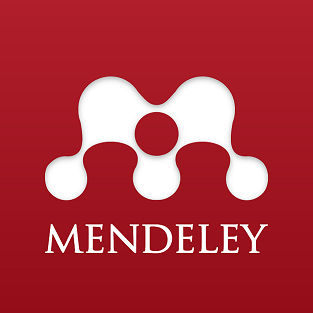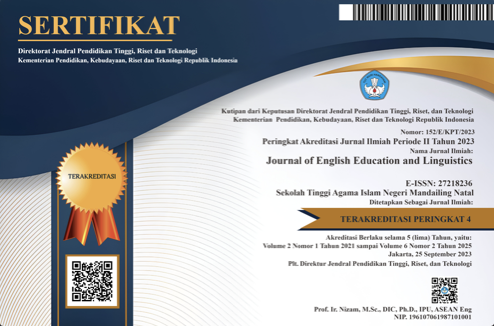AN ANALYSIS OF THE SIXTH SEMESTER STUDENTS’ MIXING CODE BETWEEN AMERICAN ENGLISH AND BRITISH ENGLISH AT ENGLISH EDUCATION STUDY PROGRAM OF UNIVERSITAS PASIFIK MOROTAI
DOI:
https://doi.org/10.56874/jeel.v1i2.279Keywords:
Error Analysis, Mixing Code, American Style, British StyleAbstract
This research aimed to find out the mixing code between American English and British English as well as the language mixing code factors performed by English students of the third year at Universitas Pasifik Morotai. The method used to analyze the data in this study was the descriptive analysis method to clarify. This study showed that the English department of the third year Universitas Pasifik Morotai performed mixing code vocabulary between American English and British English. The mixing code of the sixth-semester students is the outer mixing code. Students mix both languages and from all results of the respondents, which is more dominant to the American accent, with total vocabularies of 50 and British English 45 vocabularies. . Some reasons put forward by the students when they produce code-mixing, firstly the students want to build motivation in learning English. Secondly, code-mixing in the teaching process makes their utterance clearer when explaining so the listener could understand faster. Code-mixing in the class expresses her/his emotion or feeling to the listener. The last reason is sometimes she/he finds a word that has no representation in another language.
References
Ajibola, Michael, Oladosu. 2011. Code Mixing as a Sociolinguistic Medium in Some Selected Songs in the Nigerian Music Industry. Thesis. Ilorin: The Department of English, Faculty of Art. University of Ilorin
Anam, Mahmadul,. Shin-Hwan Chiang dan Keshab Shresta Jurnal Ekonomi Selatan Vol. 62, No. 4 (April, 1996), hlm. 1072-1078
Arikunto, Suharsimi. 1993. Prosedur penelitian suatu pendekatan praktek. Jakarta: Rineka Cipta.
Aronin, L & Hufeisen, B. 2009. The exploration of Multilingualism. Amsterdam/Philadelphia: Jhon Benjamin Publishing Company.
Barnet, R. 1994. Recovering an Academic Community: Above but Not Beyond Academic Community. London: Jessica Kingsley Publisher Ltd.
Berty, R. 2015. Code Mixing Used by Announcers of Venus Radio FM Makassar. Thesis. Makassar: Faculty of Adab and Humanities, State Islamic Bogdan and Taylor, S. 1975. Introduction to Qualitative Methods: Phenomenological. New York: A Willey Interscience Publication.
Cakrawarta, D, A. 2011. Analysis of Code-Switching and Code-Mixing in the Tenlit Canting Cantiq by Diyah Nuranindiya. Thesis. Semarang: Diponegoro University. Retrieved from: http://eprints.undip.ac.id/27046/2/analysis_of_code_switching_and_code_mixing_in_th e_teenlit_cantiq_canting_by_diyah_nuranidya.pdf. Accessed on June 10th 2016. 06:09:34 PM. University of Alauddin.
Claros, M, S, C, & Isharyanti, N. 2009. Code Switching and Code Mixing in Internet Chatting: Between ‘yes’, ‘ya’ and ‘si’ a case study. Jaltcall journal
Chaer, 2004: 114 Chaer (2004: 115) : Chear, Abdul and Leonie Agustina. 2004. Sosialinguistik: Perkenalan Awal. Jakarta : Rineka Cipta
Darragh, G. 2000. A to Zed A to Zee; a Guide to Differences between British and American English, Irun, Editorial Stanley.
Echols, J.M. & Shadily, H. 2010. Kamus Inggris Indonesia And English Indonesia Dictionary. Jakarta. PT, Gramedia Jakarta.
Fishman, 1972: 20 International Journal of the Sociology of Language. Joshua A. Fishman Rowley, MA: Newbury House, 1972
Hockett, Charles. 1958. A Course in Modern Linguistics. New York: The Macmillan Company. Jeffries, L. 2006. Discovering Language : The Structure of Modern English, New York Palgrave
Macmillan.
Kate. 2012. English Vocabulary; British and American is U.S.A, Diakses dari
Marjohan, Asril. 1998. Pengantar Sosialinguistik. Jakarta: Depdikbud. Nababan, P,W,J. 1985. Sociolinguistik Suatu Pengantar. Jakarta: PT Gramedia. Saleh Ady, S. 2017. “ Analisis Code Mixing yang Digunakan Guru di Zarindah
Marjohan, 1988: 49 Marjohan, Asril. 1988. An Introduction to Sociolinguistic. Jakarta: Proyek Pengembangan Lembaga Pendidikan Tenaga Kependidikan.
Modiano, M. 1996. A Mid-Atlantic Handbook: American and British English, Swedia, Studentlitteratur.
PWJ Nababan. Sosiolinguistik Sebagai Pengantar. Jakarta: Gramedia, 1986
Pyle, M.A., & Page, M.E.M. 2002. Preparation Guide Test for English as a Foreign Language,
New Delhi, Wiley Dreamtech India (P) Ltd.
Pateda, Mansoer.1987. Sosialinguistik. Bandung: Penerbit Angkasa.
Rahardi, R Kunjana. 2010. Kajian Sosialinguistik: Ihwal kode dan Alih Kode. Ghalia Indonesia,
Sugiyono. 2012. Penelitian Pendidikan Pendekatan Kuantitatif,Kualitatif dan R&D. Bandung:
Alfabeta. vol. 5, no. 3. Salatiga, Indonesia: The university of Melbourne and
SatyaWacana Christian University.
Sugiyono. (2008) Metode Penelitian Kualitaatif, Kuantitatif, dan R&D. (Bandung : Alfabeta,
. Hlm. 215.
Setiyadi, Bambang. (2006). Teaching English as A Foreign Languange. Yokyakarta: Graha Ilmu Suwito. 1996. Alih Kode, Campur Kode, Interferensi. Surakarta: Ninary Offset.
Wardaugh, Ronald. 1986. An Introduction to Sociolinguistic. Great Britain: Hrtnolls Ltd,
Bodmin.
Wardhaugh, Ronald. 1998. An Introduction to Sociolinguistics Third Edition. Massachussetts:
Blackweell Publisher Inc.
Downloads
Published
Issue
Section
License
All articles published in the Journal of English Education and Linguistics are licensed under a Creative Commons Attribution-ShareAlike 4.0 International (CC BY-SA) license. This means anyone is free to copy, transform, or redistribute articles for any lawful purpose in any medium, provided they give appropriate attribution to the original author(s) and Journal of English Education and Linguistics, link to the license, indicate if changes were made, and redistribute any derivative work under the same license.
Copyright on articles is retained by the respective author(s) without restrictions. A non-exclusive license is granted to the Journal of English Education and Linguistics to publish the article and identify itself as its original publisher, along with the commercial right to include the article in a hardcopy issue for sale to libraries and individuals.
Although the conditions of the Creative Commons Attribution-ShareAlike 4.0 International (CC BY-SA) license do not apply to authors (as the copyright holder of your article, you have no restrictions on your rights), by submitting to the Journal of English Education and Linguistics, authors recognize the rights of readers and must grant any third party the right to use their articles to the extent provided by the license.

This work is licensed under a Creative Commons Attribution-ShareAlike 4.0 International License.








